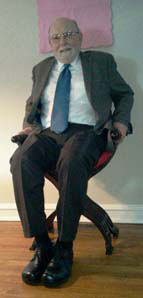
On the morning of May 16, 2016, I awoke early, thinking of Eugene Carroll and our visit five weeks ago. He had always promised to tell me about his encounter with Bernard Berenson, art connoisseur and fixture in Fiesole, but I had forgotten to ask. I’ll remember next time, I thought.
That evening, I came home from work and checked my email. When I glimpsed “Eugene Carroll” in the subject line of the first item it seemed ominous and I dreaded opening the message. Nicholas Adams, Eugene’s friend and colleague from Vassar College’s Art Department, had sent word that Eugene had died peacefully that morning at a hospital in Poughkeepsie.
A tide of emotions swept over me: sadness that we would have no more conversations, relief that his physical suffering was over, anxiety about what would happen to the website he had struggled to complete, gratitude that I had seen him one last time, and joy at the friendship my husband, Michael, and I had shared with him these last few years.
In writing this remembrance of Eugene, I’ve been through countless drafts of rambling prose and random recollections of our conversations, including this one in particular. When we visited his home in February of 2014, I asked when he anticipated publishing his website on Rosso Fiorentino. No sooner had the words left my mouth than I realized what a silly question I had posed. “When it’s done,” he responded. We laughed and acknowledged the simple truth about any creative effort worth undertaking, whether preparing a website about Rosso, rehearsing a Mozart aria, or finishing this essay. It’s done when all the elements are the right size and fit together perfectly with nothing more to adjust. We thank Eugene’s friend and ours, my fellow alumna Laura Holt, for inspiring me to make many a cut and get this to “done."
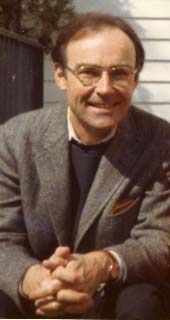
My admiration for Eugene Carroll began at Vassar College more than forty years ago when I sat in a darkened auditorium in Taylor Hall packed with students eager to acquire the basics in the famous course known as Art 105 or Introduction to Art History. My favorites were his lectures on Italian Renaissance painters. We heard about styles, techniques, and chronologies which, when mingled with Eugene’s passion and dedication to the subject matter, compelled artists and their works to come alive while he explained what touched and intrigued him about them; what he admired.
By the luck of the draw, I ended up in Eugene’s seminar, the weekly gathering of a small group of Art 105 students to discuss the subject matter of the lectures in a more intimate environment. Eugene was in his element, encouraging us to describe what we observed and why. Never dictating orthodox viewpoints, he prodded us to perceive, inquire, and reflect. How tolerant he was of undergraduates with mush for brains, or at least that’s how I felt as a senior who was not majoring in Art History. Eagerly, I soaked it all up.
What developed in me over the course of that year were a more discerning eye and an acute memory for detail within the stylistic traditions of the Old Masters. I might be peering at the umpteenth Sacra Conversazione but I could tell who painted it and what made it special. The objectives were never about regurgitating Eugene’s ideas. Instead, it was about being my own person, confident of my powers to probe, to ponder, to digest, and to articulate. As undergraduates we may have been fledglings, but when flung from the nest we would soar. Launched on my way by Eugene’s insights and encouragements, I clutched my notes from his classes for decades as I visited museums across Europe, jotted down observations, and developed enduring bonds with paintings, including those once projected larger than life on the screen in Taylor Hall.
From those early years, I can’t recall that I ever told Eugene how grateful I was. What gave me the chance to do that and to reconnect with my alma mater was a 2010 television series on the History Channel called Engineering an Empire. Discussing Italian Renaissance architecture and its military applications was Nicholas Adams, Mary Conover Mellon Professor of Art History. So excited was I to see someone from Vassar featured on TV that I emailed him and congratulated him on his achievement. What followed was correspondence including how my Vassar education, and knowledge imparted by Eugene, had sustained my passion for the Arts while doing my day job as a tax lawyer and helping my husband with our French antique import business.
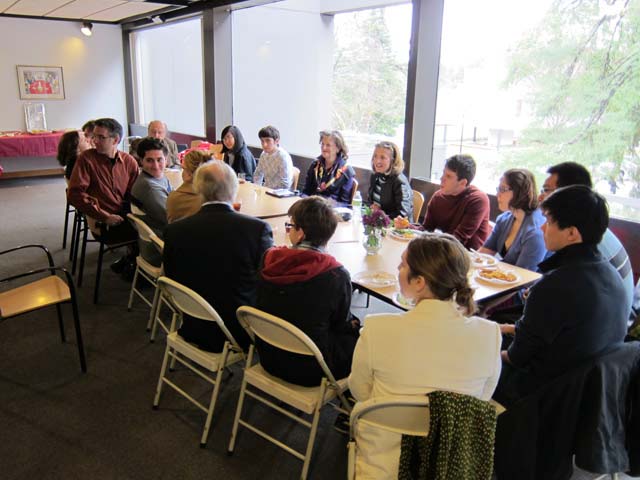
At Nick’s suggestion, the Career Development Office invited me to speak to students about the importance of an Arts education in pursuing a business career. The talk led directly, after a six-year incubation period to find the right sponsors, to The Art of Business luncheon becoming a fixture – at the crossroads of culture and commerce – in Houston.
Not only did Nick Adams attend the talk at Vassar, but he brought along Eugene Carroll. “You’ve lost weight” were the first words out of his mouth and an affirmation that he did remember me from the days when I was 20 pounds heavier thanks to Vassar’s Central Dining. I introduced him to Michael and he invited us for paella the next day at his favorite Spanish restaurant.
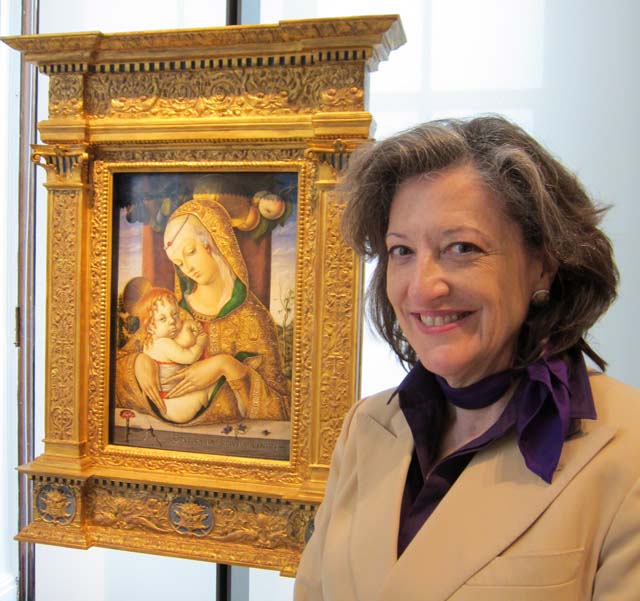
Over lunch, we learned that Eugene was continuing his scholarship dedicated to Rosso Fiorentino, the red-headed master from Florence who crossed the Alps, like Leonardo da Vinci, to work at the court of King Francis I of France. Rosso’s drawings, prints, and decorative arts had been the subject of an exhibition at the National Gallery of Art in Washington, DC in 1987 for which Eugene authored the catalog. He was now working on the definitive website about Rosso, cataloguing and describing all of his works including the vast projects for the Château at Fontainebleau outside Paris.
During lunch I confessed my obsession with Carlo Crivelli, the Venetian exile who spent his productive years in Eastern Italy while evolving a singular style of painting rich in decorative details. On a visit to London’s National Gallery in 2004, I happened upon an entire room full of works by Crivelli. Struck as if by a bolt of lightning, I was overwhelmed by the drama, the tenderness, the exquisite ornamentation and textures, as well as the intimacy and immediacy. In an instant I had been transformed, like Saul on the road to Damascus. While perhaps not one of Eugene’s favorite painters, Crivelli was the subject of many of our conversations as he encouraged me to follow this passion wherever it led.
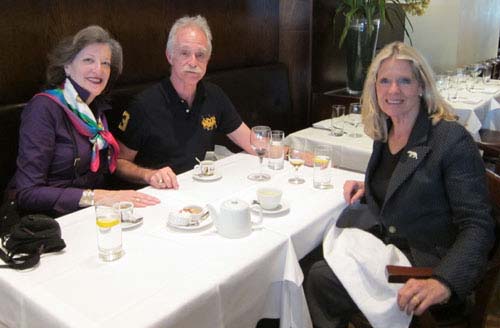
From that luncheon onward, Eugene came along with us – virtually – on many trips to Europe. In 2012, Michael and I headed to Umbria and lodged at the Hotel Palazzo Brufani where Eugene had first stayed in Perugia more than 50 years earlier. Accompanied by his notes from past visits to the region, we followed in his footsteps and sent him daily updates by email as we explored the surrounding hill towns and visited all the Peruginos in Perugia. Trips to London, Paris, Rome, Vienna, Malta, Prague, and Naples followed, always involving adventures we delighted in sharing with Eugene.
For a trip to London in the fall of 2011, Eugene suggested I meet one of his former students, Laura Holt, a theologian who had been Deputy Director of the study abroad program of the University of Notre Dame. He was right that Michael and I would find we had much in common with her and that a friendship would blossom. Laura now lives in our former neighborhood in Los Angeles and passes often the church where Michael and I met and were married.
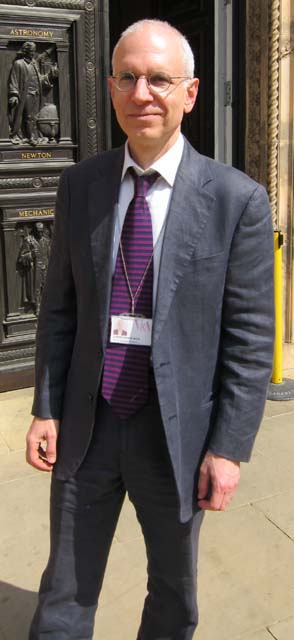
Even before reconnecting with Eugene, and thanks to an item in the Vassar Quarterly, I contacted Christopher Wilk, Keeper of Furniture, Textiles, and Fashion at the Victoria & Albert in London. It turned out that Christopher and I had taken Art 105 at the same time but he had gone on to major in Art History. How grateful we are to Christopher for his friendship and the many insights that have inspired not only research and writings for M. Markley Antiques but enduring conversations and a few homework assignments from Eugene.
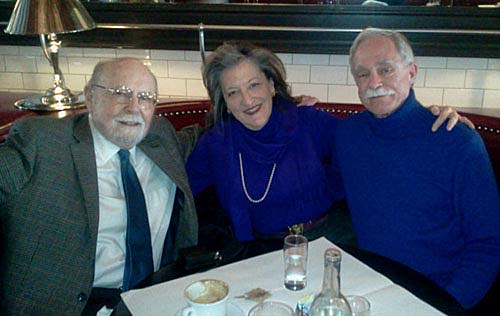
In February of 2014, we traveled to New York City for a concert and to Poughkeepsie for a visit with Eugene. Lunch was at another of his favorite restaurants, where he enjoyed Oysters Rockefeller and we introduced him to Argentina’s prized Malbec wine.
Afterwards, we spent a few hours with him in his home on campus. We felt privileged to visit his study, surrounded by the works that inspired and informed him for over a half-century. From the image of Rosso’s Portrait of a Young Man (from Naples’ Museo Nazionale di Capodimonte), displayed on an over-sized computer monitor, came a homework assignment for us to figure out the origin of the carpet featured prominently in the work and to look for certain details in person during our upcoming trip to Italy.
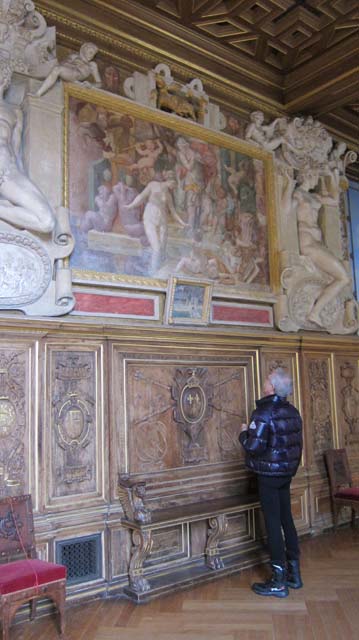
Early 2015 found us in Paris and with another homework assignment. It involved locating a diminutive figure of a man in a tiny fresco of the Château at Fontainebleau as painted by Rosso in the Galerie François Ier while he was working on it. A recent restoration seemed to have eliminated this figure and it was our job to investigate. Try as we might and armed with our special camera for photographing the minutest details, we could find no trace. But we spent an enjoyable afternoon in the frigid Château reacquainting ourselves with Rosso’s genius, underscoring Eugene’s fascination with him.
Events in New York City in April of 2016, hosted by the International Friends of the Kunsthistorisches Museum Vienna (KHM), offered the ideal opportunity for another visit with Eugene. But as the appointed day approached, I called and emailed, getting no response. With the help of Nick Adams, I tracked Eugene down at a rehabilitation center in Hyde Park where he would be happy to welcome me and I could even come along to therapy sessions.
When I arrived we jumped right into a discussion of the Rosso Fiorentino website. Eugene hoped to have some retrofitting done at home so he could return there soon and resume work on the website.
As always, the conversation quickly turned to Crivelli and a report on my most recent encounter with the master. A business trip to Washington, DC had afforded me a precious hour in the room at the National Gallery with Rosso’s Portrait of a Man, who gazes across at Crivelli’s Madonna and Child Enthroned with Donor. The guard had kept a watchful eye on me as I scrutinized each work, pacing back and forth between them and scribbling away on the back of my boarding pass. I described to Eugene how enthralled I was by the iridescent effect of the pigment used to depict the Baby Jesus’ fingernails, a feature he found captivating and one I’d never noticed in viewing countless reproductions of the work. Was it the master’s touch or a restorer’s caprice? Eugene acknowledged that no matter how many times one sees a picture in a book or on a screen in a lecture hall, there is nothing more rewarding than staring at it from a few feet away and relishing every luscious detail that the artist took pains to create.
It had been a day full of interruptions, but our conversation flowed from topic to topic while I marveled at Eugene’s boundless curiosity. He pursued the understanding of his medical conditions and courses of physical therapy with the same diligence he applied to scholarly pursuits and discussions of pictures. He bore with nobility the indignities of being in a place that was not his home, tended by people who called him “Gene.” Getting on well with everyone, he encouraged his therapists to name Renaissance painters they had heard of and he corrected them gently whenever Van Gogh was on the list.
I fully expected Eugene to return home and I never dreamed that this meeting would be our last. As it came time for me to head back to the city, we sat in the lobby surrounded by some of the impressionistic scenes of Italian landscapes on display throughout the facility. He remarked about the salutary effects of the deep perspective, even if the renderings were a bit fuzzy. The one over my chair was of the Grand Canal in Venice. Eugene scrutinized it and chuckled at the notion that the six-story stone palazzo in the foreground could ever have been supported by the wood pilings on which the ancient city was built. He liked them all, evocative as they were of another time and of his years exploring Italy as a young man.
It is now too late to share with Eugene the chance meeting the following day, at the KHM event, with one of his former students and with a museum director. He would have enjoyed hearing how his influence on the three of us, strangers to one another, had led to divergent careers with an unflagging passion for Italian Renaissance painters.
Our world is not the same without Eugene Carroll but we hope to carry on, in tribute to him, with the skills and passion he instilled in us. By now, we hope he will have met up with Rosso in heaven, where the master has resolved the enigma of the figure in the fresco. Perhaps it will have reappeared when we visit Fontainebleau again later this year to complete our final homework assignment for Eugene.
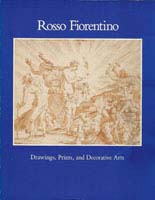
Since 2018, Eugene's collected papers are available at Vassar College Library.